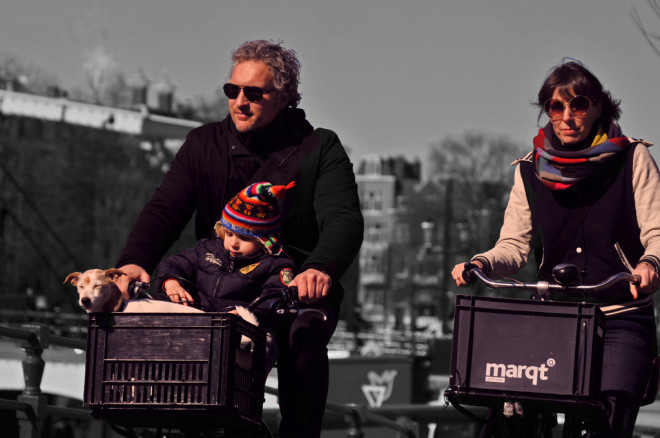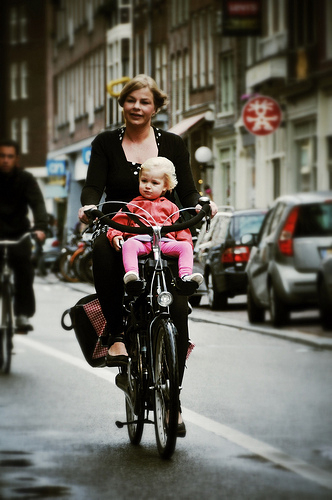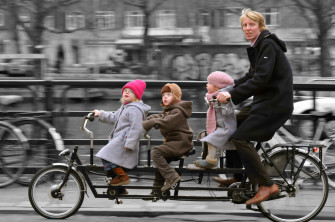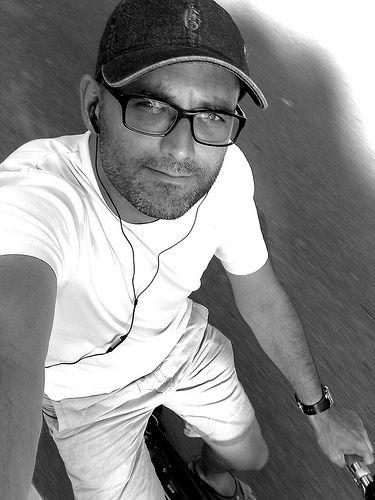
"Bicycle Cultures Are Man Made": Amsterdamize Guest Post
I was asked by ECF to tell you a little bit more about Dutch bicycle ‘culture’ and Amsterdam in particular. And it starts right there: I use quotation marks for ‘culture’, because there’s a big difference in how the Dutch understand this word and how it’s defined and used abroad. To have understanding about the differences and commonalities there needs to be context, and this is an important context to start off with.
Outside the Netherlands (particularly in the English-speaking world) ‘bicycle culture’ is generally defined by its minority status: within the whole transportation & lifestyle spectrum, urban cycling forms very much a ‘sub-culture’, eager to become mainstream. Either marginalized by society or just not overly prioritized on a policy level, there everyday cycling is far cry from ‘cycling is for everyone’.
Cycling is so much part of everyday life in the Netherlands that not many Dutch people give it a second thought, let alone recognize the ‘culture’ part of it. It’s that normal. As normal as water from the tap. It’s just there and we use it. And yes, the Dutch take it for granted. Which can be tricky with regards to advocacy, but on the whole it’s a very positive thing.
Following the popular discourse: Amsterdam is unlike any other city. In the same way any other city is not Amsterdam, but unique in itself. The same applies to the whole country. Allow me to explain.
Amsterdam has the reputation of being the Bicycle Capital of the World. Rightly so. In the world of everyday cycling there is no other place like it. Yes, Copenhagen is up there as well, but we’ll let wonks and data miners worry about the numbers. What’s more telling is that the Netherlands on a whole have hundreds of ‘Copenhagens’. Cycling in the Netherlands is ubiquitous.
A population of just 16.7 million souls, owning close to 20 million bicycles. Virtually every Dutch person cycles, to a greater or lesser extent, be they young or old, rich or poor.
A few samples: 27% of all movements in the Netherlands are by bicycle. 80% of all Dutch cycle at least once a week. The average age for a child to cycle to school (or otherwise) independently is 8 years (which has the Dutch worried, as that used to be 6 years). On average, the Dutch make 14 million cycle trips a day, each covering 3,5 km on average. Per year, the Dutch travel well over 200 billion km by bike and the average distance pedaled per person is still rising. During rush hour, there are more people going from a to b (for all purposes) by bicycle than by car. Since 2007 the number of bike trips in Amsterdam is greater than the number of car trips. Amsterdam has a bike modal share of over 50% in the downtown area, 38% in the greater city. The city of Groningen (the actual Cycle Capital of the Netherlands) has a modal split of over 60%. 40% of Dutch train commuters get to the station by bicycle. Train stations have a total of 200.000 bike parking racks. This is far from enough, as current and rising demand (over 10% each year) actually require a minimum of 400.000 racks.
Contrast these few samples with other places and most people will conclude (and actually have) they are unimaginable, ‘out of this world’ and, I hear and read this a lot: it would be unattainable, impossible to replicate. Here’s the kicker: nothing could be further from the truth.
There are a few very persistent myths circling the globe about cycling in Amsterdam, and the Netherlands in general: - the Dutch have, for some undefined reason, always cycled. Also known as: ‘cycling is in their blood/DNA;
- the Dutch cycle so much because the city/country is flat as a pancake;
- it’s a small country, everything is close by
- the Netherlands have a moderate climate
- car drivers are all well-behaved
I could go on. Of course it’s a very well-established human condition: the need to find excuses why some (the minority) do or have something the others (the majority) don’t.
It’s persuasive and powerful, persistent to a degree that it doesn’t just dominate the general public discourse, many bicycle advocates and organizations abroad often don’t allow themselves to look beyond these myths. This of course stems from being unfamiliar with the essence of Dutch bicycle policies, the many differences in social attitudes towards everyday cycling and the reluctance to divert from familiar paths, while feeling trapped within the status quo of car-centric policies and spending, resulting in bicycle-unfriendly infrastructure (to put it mildly).
By the logic of the aforementioned myths, we actually wouldn’t be talking about the ‘uniqueness’ of Dutch ‘bicycle culture’, we would instead have seen hundreds, if not thousands of Amsterdams and Groningens emerge around the world by now. But we haven’t. Instead, we often hear ‘But this is not Amsterdam’.
When the majority of people feels it’s unsafe to cycle, they won’t. Only the brave will.
As proprietor of the website Amsterdamize and acting as a Bicycle Ambassador on the global stage with the emerging interest for cycling, I try to show the essence of cycling in the Netherlands by recording this urban cycle life as it reveals itself to me on a daily basis. Nothing more, nothing less. I attempted to do the same when I wrote and produced the promotional film for the Dutch Cycling Embassy, putting the Dutch success in a much-needed historical context.
[[{"type":"media","view_mode":"media_large","fid":"482","attributes":{"class":"media-image","typeof":"foaf:Image","height":"225","width":"400","style":""}}]]
Cycling For Everyone from Dutch Cycling Embassy on Vimeo.
Bicycle cultures are man-made. It’s a choice.
Yes, the Dutch have been in that place where many cities and countries find themselves now. At the expense of too many lives lost and a degrading quality of urban life, they came to terms with outdated and one-sided urban/road design, citizens rose up and decided a different way was needed, putting people and livable cities first. Through trial and error, sustained efforts and a long-term vision the Dutch managed to reverse a downward trend and put bicycles back on the map & make them a viable part of our lives again. Fast, convenient, comfortable and safe.
My point: each city has its own particular history regarding design, architecture and social contract, but in essence humans behave the same way the world over. When you facilitate a particular mode of transportation and make it safe and convenient, people will use it. This was the case for automobiles and this is certainly the case for bicycles.
The bottom line: there are more similarities than differences between the Netherlands and the rest of the world when it comes to everyday cycling. There’s more than meets the eye, too, you just have to have an open mind.
Bicycle cultures are man-made. It’s a choice. Cycling should be for everyone, not just the brave and few.
About the Author
Marc van Woudenberg runs the Amsterdamize website and is well known on the bicycle scene in both Europe and around the world. As a marketing/media professional he played an instrumental role in the recent launch of the Dutch Cycling Embassy and makes regular appearances at cycling related conferences. He has set himself up as an independent Bicycle Ambassador, consulting cities and organizations on bicycle marketing strategies and campaigns.
Disclaimer: The views represented in this article do not necessarily represent those of ECF and its members.
Regions:
Contact the author
Recent news!
Upcoming events
Contact Us
Avenue des Arts, 7-8
Postal address: Rue de la Charité, 22
1210 Brussels, Belgium














